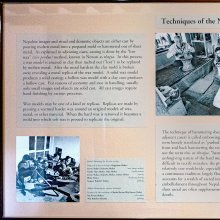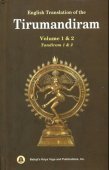Sangam, Śaṅgam, Saṅgam, Shangam: 7 definitions
Introduction:
Sangam means something in the history of ancient India, Hindi, biology. If you want to know the exact meaning, history, etymology or English translation of this term then check out the descriptions on this page. Add your comment or reference to a book if you want to contribute to this summary article.
Images (photo gallery)
India history and geography
Source: academic.ru: South Asian ArtsEarly classical Tamil literature is represented by eight anthologies of lyrics, 10 long poems, and a grammar called the Tolkāppiyam (“Old Composition”). According to a fanciful Tamil tradition, this literature was produced by poets of three “academies,” or śaṅgams, that in the hoary past were centred in the southern Indian city of Madurai and supposedly lasted 4,400, 3,700, and 1,850 years, respectively. The Tolkāppiyam was ascribed to the second śaṅgam, the eight anthologies and 10 long poems to the third; according to tradition, nothing is extant from the first śaṅgam.
The early literature, itself known as Saṅgam, comprises 2,381 poems, ranging from four to nearly 800 lines each and assigned to 473 poets who are known by name or epithet; about 100 poems are anonymous.
The eight anthologies and their contents, excluding opening invocations that were added later, are as follows: akam anthologies consisting of
- Kuṟuntokai, 400 love poems,
- Naṟṟiṇai, 400 love poems,
- Akanāṉūṟu, 400 love poems,
- Aiṅkuṟunūṟu, 500 love poems, each 100 (assigned to a different poet) dealing with one of five phases of love,
- Kalittokai, 150 love poems in a metre called kali; and puṟam anthologies consisting of
- Puṟanāṉūṟu, 400 poems,
- Patiṟṟuppattu (“The Ten Tens”), 100 poems on kings (the first and last decades are missing),
- and Paripāṭal, a collection of 70 religious poems.
Paripāṭal and Kalittokai appear to be the latest of the anthologies; Kuṟuntokai and Puṟanāṉūṟu probably contain the earliest compositions. The remarkable work of grammar and rhetoric, Tolkāppiyam, is the crucial text for an understanding of early Tamil language and literature. Divided into three sections (each consisting of cūttirams, or aphorisms)—sounds, words, and meaning—the Tolkāppiyam details, in the third, the canons of Śaṅgam poetic traditions.
Source: Shodhganga: The significance of the mūla-beras (history)Saṅgam (Caṅkam) literature is aptly regarded as the crown of Tamil literature. The ancient works, Pattupāṭṭu (a collection of ten ancient Tamil poems) and Eṭṭutokai (the eight anthologies of the Caṅkam period) give details about the art of dance in the Caṅkam period. Caṅkam (Saṅgam) literature informs that Ātimanti, daughter of King Karikāla and a noteworthy queen in the Chola kingdom; Āṭṭanatti, a chieftain of Chera dynasty and Āṭukoṭpāṭṭu Ceralātan, a king, were experts in the art of dance. Caṅkam literature provides the information that the members of the royal family, along with the poets, practised the art of dancing.
Caṅkam (Saṅgam) literature brings out the details regarding the land, the area, the dressing of kuṟavai kūttu (a dance form danced in a circle by the women of the hill tracts). It enables the readers to know the reason for this dance form, the way it was performed, the dancers, and the music used for it. The details about tunaṅkai kūttu, its period, place, area, the dancers and the dance form are also found in Caṅkam literature. The dance is performed by joining the hands and beating across the ribs. Since the king also participated in this dance, this was supposed to have been regarded highly by the people. Thus Caṅkam (Saṅgam) literature beautifully explains how dance was practiced in daily life and how kūttar and viṟaliyar danced and entertained the kings and the people.
Source: Cologne Digital Sanskrit Dictionaries: Indian Epigraphical GlossarySaṅgam.—Tamil; same as Sanskrit saṅgha; an assembly of ancient Tamil poets; the name given to an assembly of poets reported in tradition to have functioned in three different pe- riods. The poets are believed to have been both literary critics and composers. Literary compositions of the age were later collected and compiled into anthologies known as Eṭṭuttokai, Pattuppāṭṭu and Padineṇkīḻkaṇakku according to their contents and size. The saṅgam is stated to have flourished at Kūḍal (also called Madurai in later literature) in the first and last period and at Kavāṭapuram in the middle period. The latest limit for the first two anthologies may be placed round about 700 A.D. See M. S. Purnalingam Pillai, Tamil Literature, pp. 14-18; S. Vaiyapuri Pillai, History of Tamil Language and Literature, p. 38. Note: saṅgam is defined in the “Indian epigraphical glossary” as it can be found on ancient inscriptions commonly written in Sanskrit, Prakrit or Dravidian languages.

The history of India traces the identification of countries, villages, towns and other regions of India, as well as mythology, zoology, royal dynasties, rulers, tribes, local festivities and traditions and regional languages. Ancient India enjoyed religious freedom and encourages the path of Dharma, a concept common to Buddhism, Hinduism, and Jainism.
Biology (plants and animals)
Source: Wisdom Library: Local Names of Plants and DrugsSangam in the Marathi language is the name of a plant identified with Volkameria inermis L. from the Verbenaceae (Verbena) family having the following synonyms: Clerodendrum inerme, Clerodendrum ovalifolium. For the possible medicinal usage of sangam, you can check this page for potential sources and references, although be aware that any some or none of the side-effects may not be mentioned here, wether they be harmful or beneficial to health.
Sangam [சங்கம்] in the Tamil language, ibid. previous identification.
Source: Google Books: CRC World Dictionary (Regional names)Sangam in India is the name of a plant defined with Clerodendrum inerme in various botanical sources. This page contains potential references in Ayurveda, modern medicine, and other folk traditions or local practices It has the synonym Volkameria commersonii Poir. (among others).
Example references for further research on medicinal uses or toxicity (see latin names for full list):
· Systema Vegetabilium (1825)
· Enum. Hort. Berol. (1809)
· Flora Indica (1832)
· Cytologia (1982)
· Species Plantarum (1753)
· Cytologia (1983)
If you are looking for specific details regarding Sangam, for example extract dosage, diet and recipes, chemical composition, side effects, health benefits, pregnancy safety, have a look at these references.

This sections includes definitions from the five kingdoms of living things: Animals, Plants, Fungi, Protists and Monera. It will include both the official binomial nomenclature (scientific names usually in Latin) as well as regional spellings and variants.
Languages of India and abroad
Hindi dictionary
Source: DDSA: A practical Hindi-English dictionarySangam in Hindi refers in English to:—(nm) a confluence; union; junction, juncture; federation; ~[na] meeting, coming together..—sangam (संगम) is alternatively transliterated as Saṃgama.
...
Nepali dictionary
Source: unoes: Nepali-English DictionarySangam is another spelling for सङ्गम [saṅgama].—n. 1. meeting; union; 2. association; company; society; fellowship; 3. contact; touch; 4. confluence;
Nepali is the primary language of the Nepalese people counting almost 20 million native speakers. The country of Nepal is situated in the Himalaya mountain range to the north of India.
See also (Relevant definitions)
Starts with (+29): Canka-mataipalli, Cankamalinkam, Cankamam, Cankamanti, Cankamar, Cankamilar, Cankamuttirai, Cankamvanki, Cankamvanku, Samgamakankshi, Samgamalalasa, Samgamatra, Samgamavari, Samgami, Samgamiya, Samgamiya, Samgamuddamari, Sangama, Sangama-sahara, Sangamabheri.
Ends with (+37): Acankam, Aikkiya-nanavacankam, Akshasangam, Alocanaiccankam, Anakshasangam, Apacankam, Aracankam, Arucankam, Asangam, Atikappiracankam, Atipaticcankam, Atippiracankam, Avyatishangam, Cakkarakapirasankam, Carcankam, Cata-koticankam, Catucankam, Cavicankam, Cen-ciluvaicankam, Iracankam.
Full-text (+378): Shangam-kuppi, Mutarcankam, Sangama, Purananuru, Natrinai, Kuruntokai, Tirumurukarruppatai, Sankam, Mutukuruku, Asangam, Yathasangam, Muta-tirumaran, Kallatanar, Anakshasangam, Mutunarai, Akshasangam, Mamulanar, Kay-cinavaluti, Kutturavuccankam, Nihsangam.
Relevant text
Search found 29 books and stories containing Sangam, Śaṅgam, Saṅgam, Shangam; (plurals include: Sangams, Śaṅgams, Saṅgams, Shangams). You can also click to the full overview containing English textual excerpts. Below are direct links for the most relevant articles:
Pandithorai Thevar < [April – June, 1983]
The Tamil Academy: A Myth < [November, 1928]
Tamil Literature < [January 1953]
Annadatri-carita (study) (by Sarannya V.)
5. The Grand feast in Sangam Literature < [Chapter 1 - The Myth of Grand Feast]
5. Uthiyan Cheralathan as a King < [Chapter 2 - Depiction of King Utiyan Ceralatan in History and Literature]
2. The Capital of the Chera Dynasty < [Chapter 2 - Depiction of King Utiyan Ceralatan in History and Literature]
Temples of Munnur (Historical Study) (by R. Muthuraman)
Garga Samhita (English) (by Danavir Goswami)
Verse 1.1.31 < [Chapter 1 - Description of Śrī-Kṛṣṇa’s Glories]
Verse 2.9.20 < [Chapter 9 - Brahmā’s Prayers]
Verse 8.10.6 < [Chapter 10 - The Paddhati and Paṭala of Lord Balarāma]
Shrimad Bhagavad-gita (by Narayana Gosvami)
Verse 18.6 < [Chapter 18 - Mokṣa-yoga (the Yoga of Liberation)]
Verse 5.11 < [Chapter 5 - Karma-sannyāsa-yoga (Yoga through Renunciation of Action)]
Verse 18.9 < [Chapter 18 - Mokṣa-yoga (the Yoga of Liberation)]
Temples in and around Madurantakam (by B. Mekala)
Political History (3): Karikala < [Chapter 1 - Historical Backdrop]
Evolution of Temples in Tamil Nadu < [Chapter 2 - Temples: Role and Influence]
Political History (5): Kalabhras < [Chapter 1 - Historical Backdrop]
Related products


